|
Latest Update (Part 2)
Travels and Adventures
August 3, 2015 - August 5, 2017
HIGHLIGHTS
* Building a House, by Hand, on a Jungle Island
* Beth Plays Tarzan
* Building a House, on a Jungle Island, after Getting Run Over by a Category Five Cyclone
* Keeping Bird Poop Off the Deck
* Squandering Tens of Millions of Dollars in Fiji
* Swimming with Manta Rays
* Visiting the Volcano God
* Diving Our Brains Out in Vanuatu
* Still Building That House…
* An Underwater World War II Junkyard
* Conspiracy Theories in Paradise
* Diving with Tiger Sharks
****************************************************************************************
In our last section, we covered the really important part of cruising –– making changes to the boat.
This next section covers the stuff that we do from time to time when we're not working on the boat. Like sailing across oceans, visiting tropical islands, diving and snorkeling, and spending time with our friends. Anyone thinking about going cruising should be aware that this stuff doesn't have anything to do with "real cruising."
August 3, 2015 - August 7, 2015
In our last episode, we left off in Beveridge Reef. We left there to make a fast run to American Samoa, to visit some friends who had moved there.

We had a fast run, but we broke one of our reefing lines. That was surprising –- these lines are super strong spectra, and they were pretty new.

And here's what we found when we took a closer look inside the boom. We had let a rigger reeve up these lines for us a year earlier. And he had led them on the wrong side of this fitting. The line should run entirely inside the fitting –– because that's where the pulley is!
It's a testament to spectra that it took a year for these lines to break.
August 7, 2015 - August 29, 2015
American Samoa
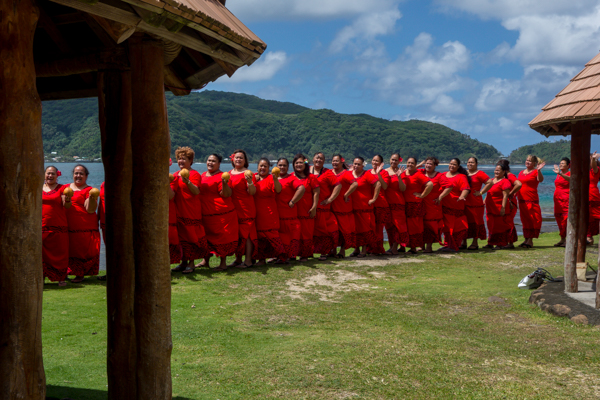
So then it was back to Pago Pago, for the second time in our voyages. A place of warm, friendly people, colorful dancing, and a very smelly harbor. Especially twice a day when the tuna canneries open their ovens –– and it smells like you just put your head into a can of cat food…
But we didn't come here for the ambience, we came to see our friends Michael, Kendra, and their son Gavin. We met these guys when they were running a marina in Fiji. They recently moved to American Samoa, and we wanted to visit them there.



Gavin, like his folks, is a very smart person. He also has a LOT of Legos. Kendra is home schooling Gavin –– as Pacific island schools often don't measure up to Western standards.

We explored around the harbor fortifications left over from World War II. Samoa left the original guns in their emplacements –– so Ken thought he had died and gone to heaven.

Michael has always liked motorcycles.

The family that bikes together –– really goes in style!

Gavin shows off his cool helmet –– complete with a plume.
August 29, 2015 - September 1, 2015
Back To Sea

We made another fast passage –– this time to the French possession of Wallis Island.

And again, we managed to break an important piece of equipment on a short passage. This is the "wind vane pivot shaft" from our Monitor wind vane self steering device. There's supposed to be a big hunk of steel welded to the bottom of this thing.

And here's the big hunk of steel. (Which we saved, because it was attached to the boat with a safety line.)
You can see in this picture that the arm which goes into this hole was only welded on one side. There should have been an additional weld on the side of the shoe facing the camera.
Ken was kicking himself here, because he had a spare pivot shaft back in New Zealand, and had decided not to carry it this season, because it was so heavy.
Scanmar really came through for us and replaced the shaft for free. But we didn't get the new piece until the end of the season in Fiji, so we lost the use of our wind vane for a few months.
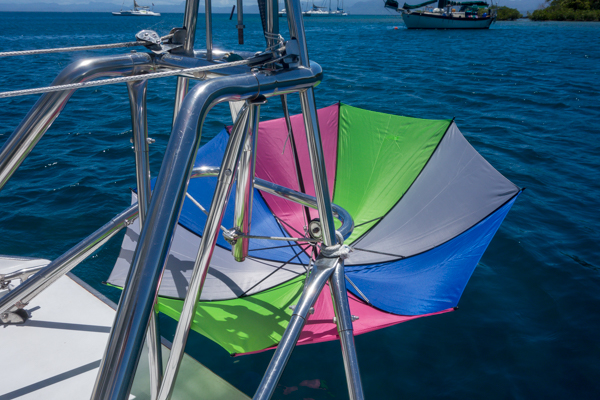
Here's Ken's repair setup in Fiji. Scanmar advises not to do repairs over the water, but Ken rigged a safety net!
At least this event allowed us to get back to the essence of real cruising again –– fixing the boat…
September 1, 2015 - September 27, 2015
Wallis Island

Wallis is a French island, as the architecture makes clear.

You've got to love French supermarkets.

A typical display on a French island. Corned beef –– considered a delicacy by most Pacific Islanders -- right next to French pate.
And you have to admire the French passion for extreme sports.



We found the French ex-pats on Wallace to be very friendly and welcoming. And very tolerant of Ken's slowly developing French.
But we were disappointed in one respect –– no good French restaurants. Turns out that the French ex-pats are only allowed to stay for four years, so not long enough to start businesses. They have to get their food fixes by trading dinner parties.
We didn't find the diving especially great in Wallis, but we did find some interesting nudibranchs (basically snails without shells –– but far more interesting, as there are thousands of very colorful species).


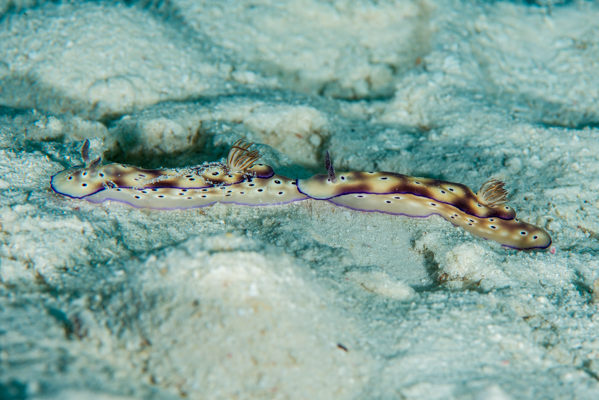
These two were engaging in "trailing behavior," where one follows the other and tries to maintain contact. Nobody is exactly sure why they do this, although it presumably has to do with sex.
If these photographs look highly processed –– they aren't. These critters really look just like this.


And here's a different, somewhat less elegant looking species.
We've developed some teamwork underwater, where Beth does most of the scouting and Ken uses his big rig to get the picture. Then while Ken spends 10 minutes shooting at one specimen, Beth looks for the next one.
September 27, 2015 - October 4, 2015
On To Fiji
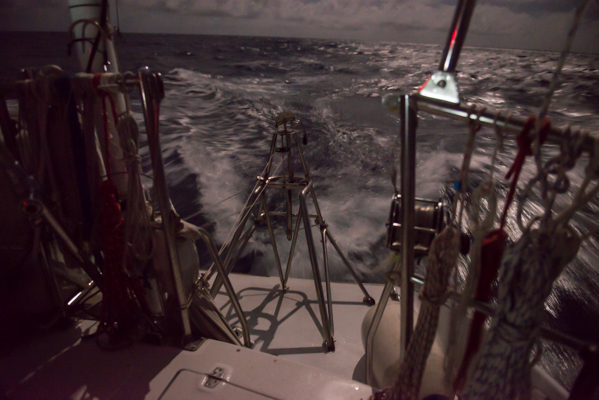
So then it was back to sea again for another great run, this time to Fiji. Here's what the boat looks like, moving fast in the moonlight. Notice that the Monitor is not doing anything here –- as we still don't have the part to fix it.

And here's a little fellow who jumped the wrong way when our boat spooked him. Unfortunately, we found him too late to help out.
October 21, 2015 - November 3, 2015
Koro Island
After we had checked into Fiji at Savusavu, we headed for Koro island to visit some friends (former cruisers) who were building a house there.
Koro is an island about 25 miles by sea from Savusavu. But if you are trying to build a house, it may as well be 1000 miles from anywhere. Let's say that you discover that you need some nails. First, you have to find a way to get 8 miles to the south end of the island –– despite the fact that there are very few cars on the island. Then you catch the twice-weekly ferry which leaves at two in the morning for an overnight trip to Suva. Then you do your shopping, and wait several days to catch the next ferry back.
And you can pretty much forget about getting any skilled help on the island.
So our friends, a Dutch couple named Hans and Dori, formerly of the boat "Happy Monster" have to be totally self-reliant.

Here's a sign that we are getting close.
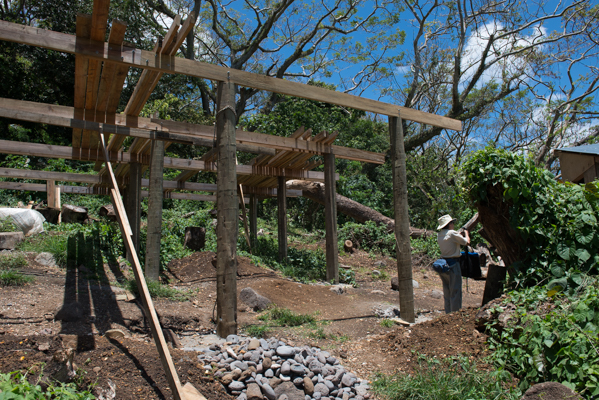
And here's the house, so far. Hans and Dori got some help from the local villagers to sink these pilings for their platform. But aside from that, they are doing all the work with their own hands.
They plan to build two geodesic domes on their platform, linked by a big screened in porch. It's all on-the-job training –– they have no background in construction, just lots of ingenuity and determination.
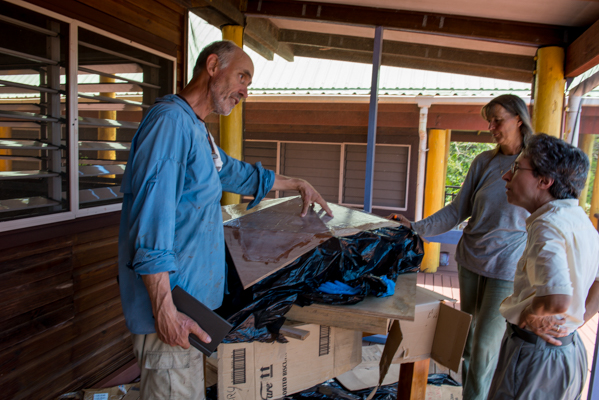
Here Hans shows Beth one of the small bits of the geodesic dome that they have fabricated from plywood, epoxy and fiberglass.

Hans mugs it up with a piece of his dome.

The work is hard and dangerous. Hans and Dori both look like those old pictures of Confederate soldiers –- not an ounce of fat. Here they sit on a tree which has just fallen in a way that threatens their water catchment tank.
The day after we took this picture, Hans started to cut up the tree with a chainsaw. He was working safely uphill of the fallen tree, but when he cut the top of the tree off, the heavy roots pivoted downhill –– throwing the part of the tree that he had been working on uphill. The enormously heavy tree knocked Hans down and pinned him to the ground in a shallow depression, and a neighbor had to cut him out with the chainsaw. If the depression had been 6 inches less deep, Hans would probably have been crushed.
Really life on the edge.

Here's another feature of life at Koro Island. Swallows.
We were pretty much the only boat in the bay, and the swallows just loved us. Sometimes there would be 30 swallows on the lifelines. Enjoying the waterfront view. With their little tails hanging out over the deck.

What a mess!
Here's the thing –– we catch rainwater off our decks for drinking. All we have to do is open the water intakes, put a rag behind the intake, and we can catch practically every drop of water that hits the boat. We can catch 300 gallons of water in one night during a nice rain.
Doesn't that sound appetizing?
Ken tried everything he could think of to get the swallows to leave, including lethal violence. But they are stubborn little guys.
We decided to come better equipped next time.
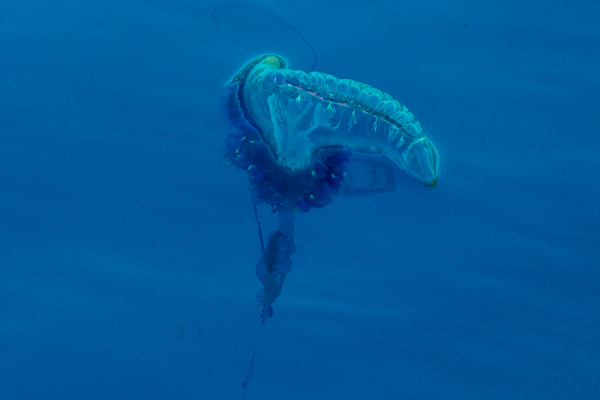
No, this isn't a discarded condom with seaweed growing on it.
Instead, it's one of the most dangerous creatures you're likely to encounter at Koro or anywhere else in the sea. This is a Portuguese Man-of-War –– about the size of a tennis ball, with long, long filaments and a very, very nasty sting. Fortunately, we didn't get stung.
We understand that these guys are more like a semi-cooperative bunch of cells operating in a colony then they are like a single organism. Primitive, but effective.
November 3, 2015 - November 20, 2015
We headed back to Savusavu to wait for a weather window to New Zealand. We checked out and were getting ready to leave after a week, but had to abort after we discovered a problem with our engine belts. We weren't totally thrilled with the window anyway, so we didn't mind the extra week of waiting.
November 20, 2015 - November 27, 2015
Back To Sea Again -- To The Land Of The Long White Cloud

Here's a novel experience –– we are seeing the tall ship Capitaine Cook on our AIS system at a range of 82.7 nautical miles. AIS is a line of sight system based on VHF radio signals. We have our antenna at the top of our mast, 70 feet off the water, and the Cook has its antenna very high up also. But still, we don't know how this happened. Even if the Cook had its antenna 150 feet up, the line of sight distance should be on the order of 30 miles.

And here is a welcome sight. We often catch these guys -- albacore tuna -- when we get within about 200 miles of New Zealand in the springtime.

Ken butchers the tuna. These guys are almost solid meat -- great for sushi.
Tuna are amazing critters. Slightly warm-blooded, to allow more energy, and totally built for speed. Their big pectoral fins fit into slight indentations along their flanks for better streamlining. And they have a thin layer of skin over the TOP of their scales, again for streamlining. And just loaded with muscle –– otherwise known as food for humans.
By the way, Ken loves this chest-high fish cleaning station on our stern scoop. Waves wash up over the scoop at sea, cleaning off all the blood and guts. Ken just washes the actual cleaning surface –– which is the fold-down part of our old life raft bracket.

And now Beth does her part. We get the fish vacuum sealed and frozen as quickly as possible -- we can process a large fish in about an hour. And it will stay fresh and tasty in the freezer for at least several months.
This guy made about a dozen meals for the two of us.
November 27, 2015 - February 25, 2016
New Zealand

Back to our adopted home in New Zealand, tied up to our favorite dock.
Notice that Ken has covered the flexible solar panels with tarps to protect their plastic covering from blowing out in the ferocious New Zealand UV.
We love these panels because they weigh less than a quarter as much is hard panels. But, it's pretty funny, really, to have solar panels that can't stand the sun.

Here is a street scene from Whangerei. Around Christmas time, which is the height of summer down under. The organizers of this street fair brought a bunch of snow in so that these kids could play in it.
Most of these kids have never seen snow before. So they're still coming to terms with things like –– it's slippery.

And engaging in their first ever snowball fights. Barefoot…

And we love walking in the woods in New Zealand. Where else are you going to find ferns that are 50 feet tall? Here's the inside of a fern tree.
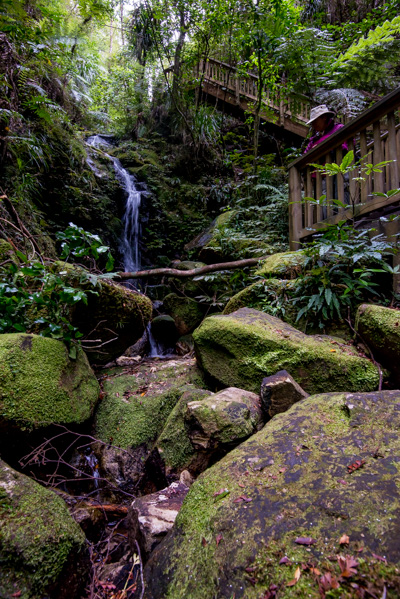
A moss covered creek bed along one of our favorite walks. If you look hard you will see Beth on the right side of the picture.

She's easier to find out in the fields.

Here's a fern just starting to unfurl.

We now have many great friends in Whangarei. This is Gabriel, and her granddaughter, Amara. Gabriel is an artist who makes the jewelry that her granddaughter is examining.

And we get to do cool things in New Zealand, like fly this helicopter simulator. The Northland Emergency Services Trust got this real helicopter from Japan –– where it had been damaged in their tsunami. And built this fantastic simulation theater around it for training.
(Actually, they cut off everything back of the cockpit. But the cockpit is the real thing.)
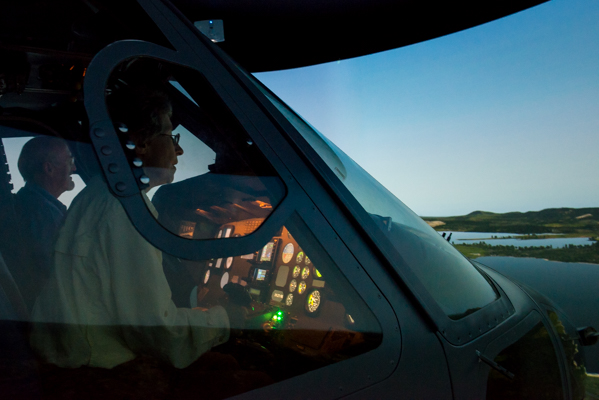
Our good friend Don Barker trains people in the simulator. That's Don in the background, letting Beth take the controls.
We concluded that flying helicopters is really, really difficult. Don compares it to trying to pat the top of your head and rub your stomach at the same time ... while balancing on top of a beach ball.
(A helicopter is inherently unstable –– nothing like flying a quad copter drone, which is dead easy.)
We both crashed and burned a lot. When you crash in the simulator, the screen turns red and yellow to simulate the fireball!
Flowers
New Zealand has almost no plants or animals that can kill you. Instead it has incredibly beautiful flowers. Really, what's not to like about this place?
So Ken really got into taking pictures of flowers. All these pictures were taken outside, in natural conditions.
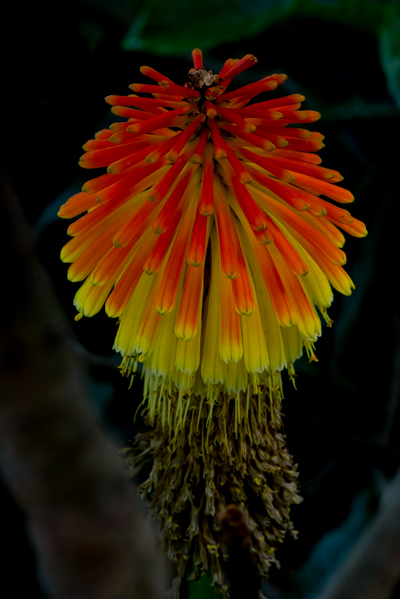
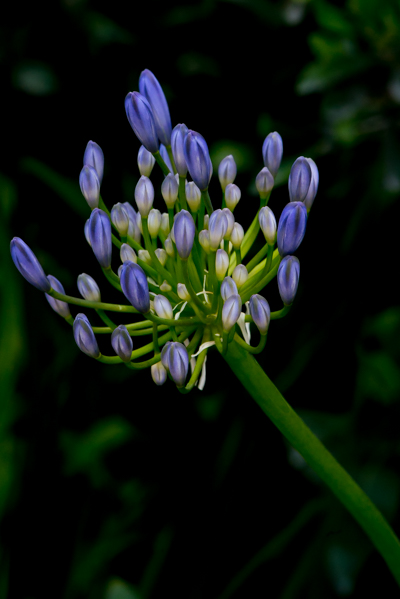







February 25, 2016 - April 8, 2016
Back In The USA
And then it was back home, to see friends and family in the USA. We covered practically the entire continent, since people are so spread out back home. Here are some highlights, in no particular order.
Beth plays Tarzan

We stopped to see Ken's old college buddy, Bob, and his family in California.
Bob is an engineer and has always been a bit of a daredevil. Here's a zip line that he built in his backyard.

Hanging around with Bob can get you killed. Here Beth misses the seat on the zip line. This is actually a bad situation –– she's just as high up as she looks. But she held on and survived. We're not going to tell her bone doctor about this…
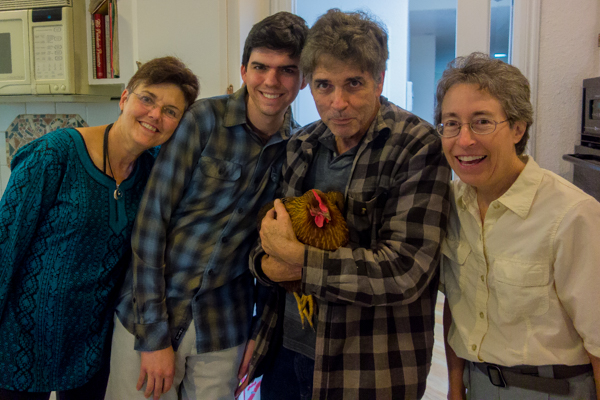
Here's Bob with wife Pauline and son Kyle. And Beth.

And chicken.

And here's the whole family, with sons David, Ryan, and Kyle.

Ryan is really a special kid. He has Downs syndrome and is also autistic, and is just the nicest, sweetest person you could imagine

Here's a shot from one of our favorite places in the whole world –– the old fortifications on top of the Marin headlands north of San Francisco. This spot always puts things in perspective -- it played an important role in our decision, so many years ago, to sail away on a sailboat.





We really love California. We figure we will end up there when we're done cruising.
Next we stopped in Colorado to see our godson Greg, and his girlfriend Leeanne. They are pretty serious rock climbers.



This stuff just never looks possible to us.

Actually, the going down part we could get into. It's the going up bit –– with your fingertips and your toes -- that looks hard to us.
**** News Flash September 2017 -- Greg and Leanne just got married! ****

We stopped in Chicago, to see our great friends Debbie and David Dranove.

Who took us to the orchid show at the Chicago Botanical Gardens.
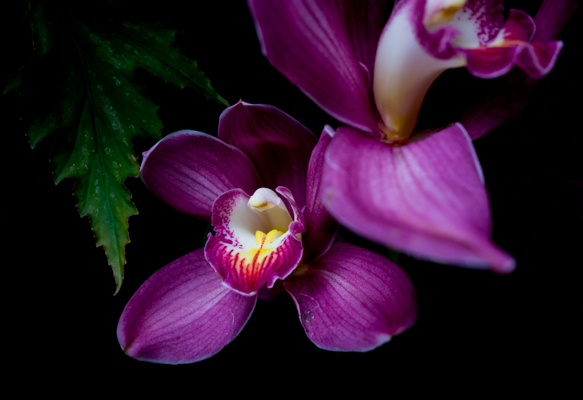
Notice how these flowers have evolved to mimic insects –– in order to attract pollinators.

We stopped in San Antonio to see Beth's sister Kay and her family. Here she is with Steve and their daughter Nicole. Playing scrabble against Nicole is like playing tug-of-war with a steamroller.
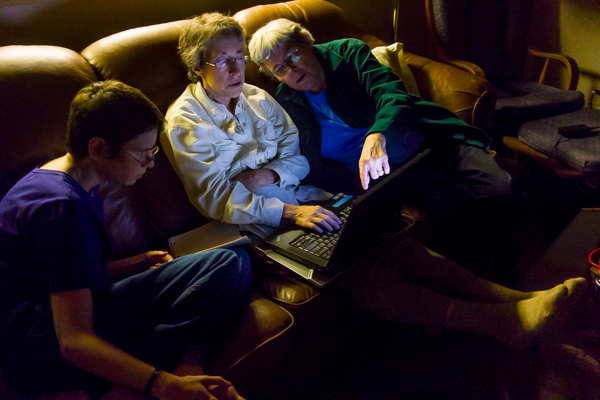
This is a very computer intensive family.

And here's their son Tom –– in his element.

We stopped at Rochester, where Ken took this portrait of his sister Cathy with her husband Rob and assorted family members.

And in Wisconsin, to see our very good friends Tim and Debbie Parker.

Debbie and Tim operate a specialized shipping depot in order to supply Eagle's Wings with all of her many logistical requirements. For which we are eternally grateful. Here's Beth, sorting through the goodies.

And we made a stop in Massachusetts, to check up on our official residence. Here's Mary Helen, our landlord, showing us her beekeeping operation.

And finally, we stopped in Florida to see Asif and Patty, who have recently bought a boat ("Shanthi") and are preparing to go cruising. Asif is a former engineer at the JPL, and worked on the Mars rover program "Curiosity".
Asif has been rebuilding their boat pretty much from the ground up, as he discovered that very few things on his cruising sailboat live up to to the engineering standards of the Mars program...

Before we left, we spent a night in a Florida hotel which caters to the cruise ship trade. It was –– how shall we say this –– a cultural experience.

This explains a lot about the cruise ships that we see out here…

And then, of course, there is American politics. Surprisingly, people around the world find our system unusual, fascinating and highly entertaining.
Ken has a strategy for solving our trade deficit. He thinks we should charge for our political news. So nobody outside the US could read or watch any coverage of our politics unless they pay a twenty dollar per month subscription fee. We'd make trillions...
April 10, 2016 - May 30, 2016
Back to Reality
And then it was time to get back to real life again. Back to New Zealand, and the mad scramble to get Eagle's Wings ready for departure.

The Tuesday night paddle board race on the Whangarei River. We have paddle boards ourselves, but this time of year, we are far too busy for such entertainment.

This is more our style, although we prefer having our heads in the boat, as opposed to in the dock.

And then it's out past the headlands and back into the big ocean.
May 30, 2016 - June 6, 2016
Back Up To Fiji

It's cold, leaving New Zealand in late May/early June. But Beth knows how to stay warm –- here she is in her "onesie."

Here is the "CIC" on Eagle's Wings. That's short for "Cruising Information Center." The chart software is displaying the contours of the bottom, some 4000 meters under our keel.
Besides the computer, radar display, and AIS, the CIC also contains the Iridium phone, the VHF radio, and a barometer. Plus the controls for the autopilot.
All this stuff really gives us a great feeling of situational awareness. Very nice, on a cold dark night in the middle of nowhere.
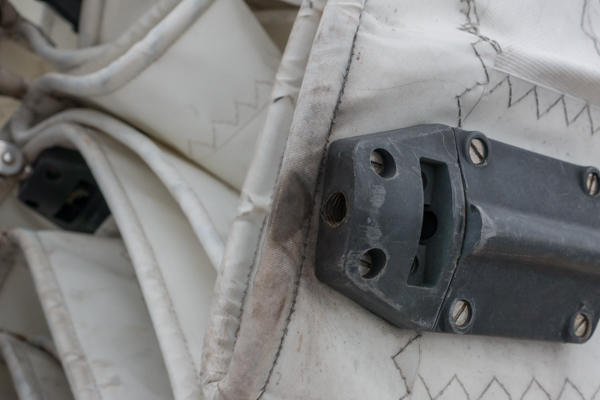
Of course, no passage would be complete without some kind of breakdown. This batten car is supposed to be attached to something that holds it to the mast.

Specifically, this bit here. Which somehow managed to unscrew itself from the batten car while we were under sail.

Here's the problem. That little coppery looking sleeve is supposed to be bonded into the plastic. But after 15 years or so, it just unbonded itself. And then it unscrewed itself.

We also found that the bolt holding the Batten car together was pretty far gone. This bolt is supposed to be the same thickness over its entire length.
We later checked every one of our bolts –– but oddly enough this was the only one that was damaged this way.

We take great satisfaction when we have the right parts on board. Here Ken emerges triumphantly from the fore peak with a brand-new batten car.


And pretty soon, we're back in business.
We later replaced all of our batten cars with new ones -- which Sailman had modified to prevent the unscrewing issue. We've had this experience a lot -- where it turns out that we were Beta testing the product.
June 6, 2016 - June 14, 2016
Safe and sound in Savusavu, our favorite town in Fiji.

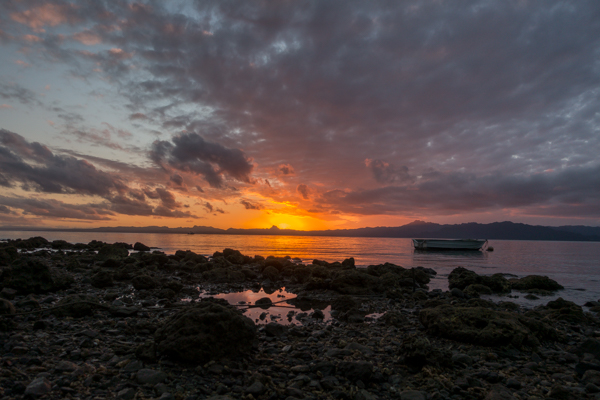


But all of this tranquility is a bit deceiving. A few months before we got here, Savusavu took a hit from cyclone Winston –– the strongest cyclone ever recorded in the southern hemisphere. And the second strongest anywhere.

Winston put 22 boats on the rocks in Savusavu. Amazingly enough, a bunch of cruisers working together managed to get virtually all of the boats back afloat before we got there. These are some of the only boats that couldn't be salvaged.
June 14, 2016 - June 23, 2016
Back To Koro Island Again

We hurried right off again to Koro Island. Koro had taken a direct hit from Winston –- the eye of the cyclone went right over the island while the thing was at its peak category five strength. We were very anxious about our friends.

We paid a visit to the village on the North Shore of Koro, which had taken a pretty serious storm surge that wiped out a lot of houses. We brought a big bag of donated clothes. And corned beef, of course.

We weren't the first people to bring assistance. Here's a tent, donated by the Red Cross.

No matter how distressed people are, they always want to pay back. Here's a lunch that the village served us.
You can see some of the wrecked buildings in the background.

And then we set off on the trek to Hans and Dori's house. The trails were a mess.

As were the boats.

And the houses.
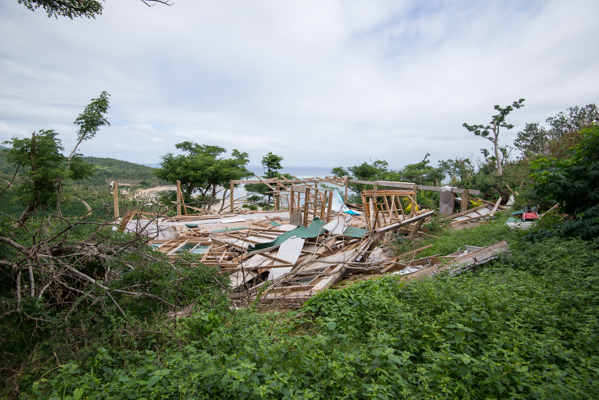
Some, more than others.

Nails were a constant threat. Many people on the island were injured after the storm, either by stepping on nails or by falling in the debris.

But fortunately, Hans and Dori had survived. They were pretty shaken up, and Dori had hurt her hip in a fall after the storm had passed. But they refused to give up on their homestead.
Life had been pretty hard for a while, with almost all of the food crops destroyed and all of the fresh water supplies polluted by the huge amount of salt water kicked up by the cyclone. Hans and Dori are hundreds of feet above sea level, but the water in their catchment tanks was still ruined by salt.
But by the time we got there things were a bit better, with enough rain for freshwater and at least a few crops growing.

And they were lucky that most of their work survived. They had still been working on their platform -- but they had not planked it over. So maybe for that reason, it didn't blow away.

But the two of them did decide to build a storm shelter under their platform before they worked on the main house above. Sounded good to us!

Here's the bathroom/shower building.

And some of the local fauna.

We were very impressed by our friends' determination and refusal to give up, after an unbelievably bad cyclone.
We did what we could to help by donating a big supply of epoxy resin and hardener –– which they use to coat the plywood for their geodesic domes, and for glassing the seams.
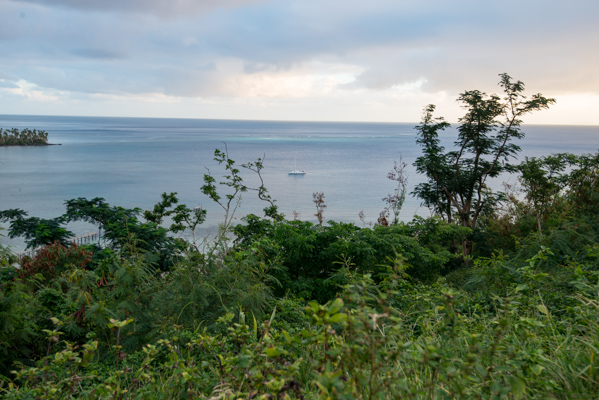
On the way back down, we had a view of Eagle's Wings in her splendid isolation out in Dere Bay.

And Hans and Dori gave us some great pumpkins. Beth makes a mean pumpkin soup!

And this year we came equipped to deal with the swallows in Dere Bay. Ken made this bird stopper out of PVC pipe and 50 pound fishing line. (This system also comes in handy for keeping birds off in New Zealand.)

Here are the attachments for the lower lifeline.

But it isn't good enough to just protect the lifelines –– those swallows will sit somewhere on the boat no matter what we do. So we decided to give them their own custom-made perch, complete with toilet facilities.

This is what you call a win-win solution.

The swallows get a place to sit, they eat the mosquitoes, our decks stay clean –– and no violence or bloodshed.
Seems like the human race needs more solutions like this…
June 23, 2016 - June 28, 2016
Namena
From Koro, we headed to Namena –– our favorite dive spot in the whole universe. Namena had also taken a direct hit from Winston, so we were anxious to see the damage.

The island of Namena was a mess –– most of the trees stripped of all their leaves. And, prior to Winston, this spot had held a dive boat harbor, capable of sheltering three good-sized dive boats. The harbor had consisted of about 50-100 giant concrete blocks, each probably about 5 feet square and 20 feet long. The harbor was just gone –– scattered up and down the shoreline as small bits of rubble.
So when people talk about a "force of nature," this is what they mean.
We snorkeled half way around the island, but the shallow coral had all been destroyed by the waves. It was very distressing.

But the deeper coral out on the main reef had survived okay. Once we got below about 10 meters everything looked normal. Here's an exotic looking "nudibranch."

We thought this guy deserved two pictures in the web site.
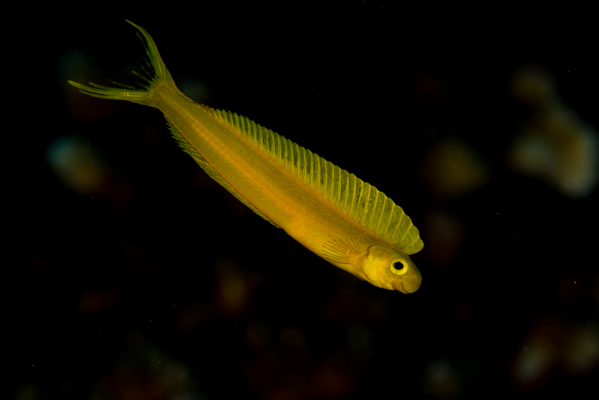
This is a "fang Blenny." These guys try to sneak up on other fish and take bites out of them. He didn't try it with us, however.
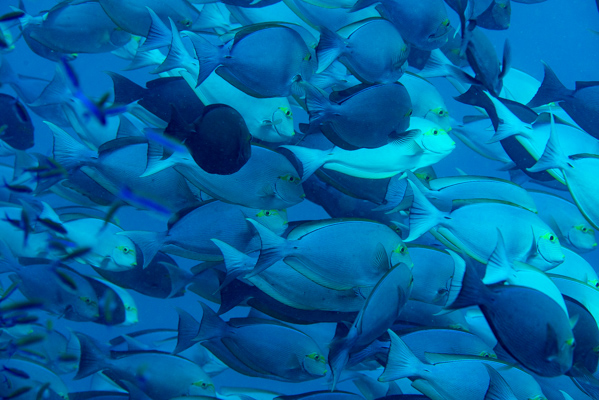
A dense school of surgeon fish.

Here's what that picture look like from the outside.

Anemone fish ready to dart into their poisonous shelter.

This is an animal –– a feather star. Usually we see these guys stuck to the coral, but this one is on the move, swimming free.
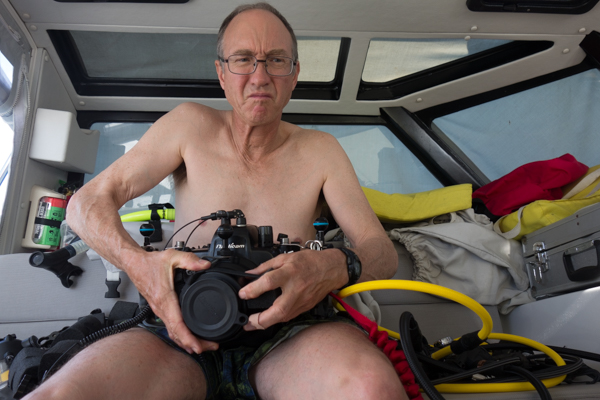
Who is this crotchety old man?

Okay, obviously Ken looks better in the water.
With a mask on.
June 29, 2016 - July 12, 2016
Savusavu, Again

And then it was back to Savusavu, to re-provision.

Fiji is new to democracy, and they are still pretty excited about it. They make a big effort to get people registered to vote.
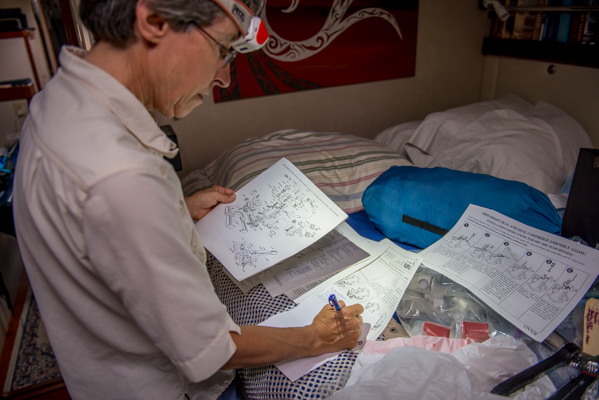
And, of course, we took the opportunity to fix the toilet. Again.

And enjoy the restaurant scene.

It's always great to head back to our snug house on the water after a nice meal on shore with friends.
July 12, 2016 - July 18, 2016
Nagelelevu
Then we moved on to revisit
Nagelelevu, up in the northeast corner of Fiji.

Here some spinner dolphins come out to greet us. These guys get their name because they jump out of the water and spin longitudinally like a football. It's really something to see. Unfortunately we didn't get a decent picture...
This atoll has a huge lagoon –– about 12 miles long and 2 to 3 miles across. It used to have a village, but the village was abandoned because it was too hard to send the children to school.
The last time we visited there were just five guys acting as caretakers.
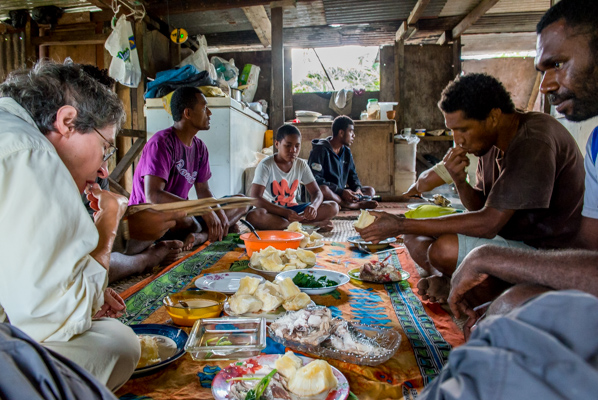
This time, we found a small group of young people who had come back to try to reestablish the village. They were gracious and invited us to a delicious dinner of fish and local root crops.

They took us to the spot where some of their ancestors are buried. In many Pacific islands, land ownership claims are best supported by your ancestors' graves.

Here's a Fijian style cigarette –– tobacco rolled in newspaper. Very healthy.

No village can be complete without a young guy who's good at climbing the coconut palms.

What's really going on here is that the lagoon is a valuable resource. And the villagers can only keep effective ownership of it by being physically on the island.
The woman talking to Beth is one of the villagers. The guys in the background are part of a commercial fishing operation that the villagers have decided to allow in.
Interestingly, these villagers claimed that the caretakers we had met last time around had been interlopers. We nodded politely –– what do we know?
Squandering Tens of Millions of Dollars

The fishing operation consisted of at least a dozen guys, with several long boats and lots of scuba gear and a dive compressor.

And here's the object of all this effort. These are sea cucumbers, also known as beche de mer.

These animals crawl along the sandy lagoon bottoms, taking sand in one end, filtering it for nutrients, and chucking it out the other end. They are essentially self-propelled intestines –– kind of like a Marine version of an earthworm, except that they don't burrow.

Here a couple of the guys clean one out in preparation for boiling.

In the wild, beche de mer don't have any predators, because any fish that eats one will get slimed with their goopy insides -– like something out of Ghostbusters. Or like getting tied up with silly string.

But the Chinese love to eat these things. And since China came into some money over the last decade, they have scarfed up practically every accessible beche de mer in the South Pacific.
So each one of these critters can now be worth between $30 and $50 US -- which is just huge money in the islands.
And here's the heartbreaking thing. When we were here last time, about five years ago, the entire lagoon in Nagelelevu was filled with beche de mer –– maybe one every two or 3 square meters. So you can do the math, but that's conservatively tens of millions of beche de mer.
And when we came here this year, they were all gone. We didn't see any in the lagoon, anywhere we looked. This fishing operation was now working the outside of the reef, in deeper water, where some of the critters could still be found.
Beche de mer are not going extinct –– they are some of the largest biomass on the planet. Down in the abyss at 4000 meters...
But they serve a purpose in the shallow lagoons –– by keeping the sand clean. So the lagoons are suffering.
And of course the Fijians are losing out on a sustainable resource that they could farm. Ken casually mentioned to the young villagers that they could have had a "beche de mer plantation" in this lagoon worth millions of dollars a year –– if they just hadn't killed off their breeding stock.
But after all, Americans killed off almost all the cod around Cape Cod. And the Kiwis cut down practically all the kauri trees in New Zealand…
People always kind of learn the hard way.
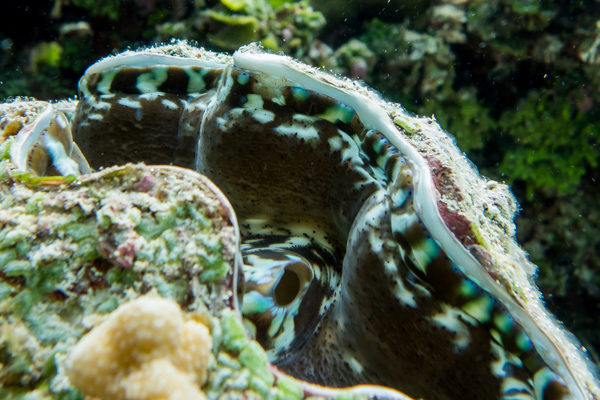


Fortunately, there were still a few beautiful giant clams in the lagoon.
July 18, 2016 - August 24, 2016
On the Dry Side of Fiji
We decided to finish our season in Fiji with a trip to the Yasawas, on the western side of the big Island.

Because the Yasawas lie on the Western, downwind side of the big Island, they have a very different climate than places like Savusavu, where it rains all the time. The Yasawas are always sunny.

And the lush, tropical jungle gives way to dry, windswept hills.

Grasslands, basically.



That's EW out there. We felt like we had the whole place to ourselves.

These dry grasslands burn frequently. So the ground was covered with a layer of ash, which the hot, dry winds blew up under our pants. We ended up covered in ash even under our clothing. Looks like Beth has one of those Polynesian tattoos.
We did a lot of diving in the Yasawas, but we weren't blown away. The coral has really suffered from warmer water temperatures and more frequent and powerful cyclones.

But we still managed to see some interesting things, like this Yellow Filament Goby, who isn't really supposed to be found in Fiji. This guy seems to have been an undocumented immigrant from Indonesia.

These are a type of hard coral.

A sea urchin hiding out in a crevice of his own making. These guys secrete an acid which eats into the limestone of the reef, creating a sheltered nook.

Here's a top-down view of a "meandering" coral –– sometimes called a brain coral.

A side on view of the same brain coral.

A mated pair of Bluestreak Gobies, hanging out on the bottom, ready to dart into their burrow.

This beautiful guy is probably the most common species of nudibranchs that we see here.
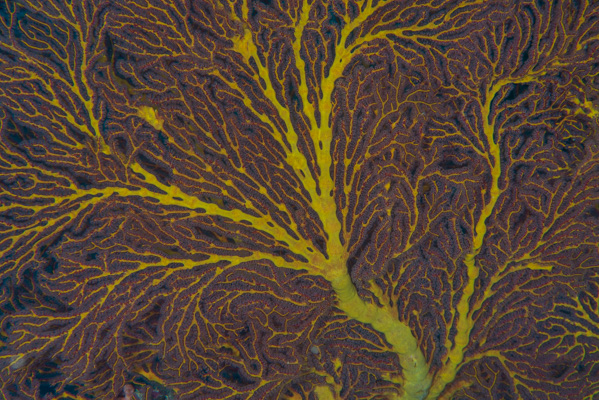
A lovely fan coral.

A different species of coral, called a goniopora.

These beautiful creatures are a type of animal –– a Christmas tree worm.

They dig tubes into the solid coral rock, and they can instantly retract into their tube if you disturb them.
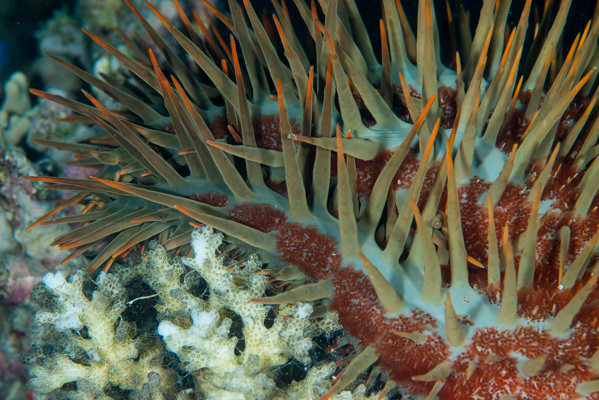
And this ugly looking creature is called a "Crown of Thorns Starfish". It's a vicious predator which destroys the coral by sucking the juices out of the polyps.
These Crown of Thorns appear like a plague in reefs with too much nutrient buildup. And they are almost impossible to kill. If you stab one with a spear, or cut it into pieces, the pieces will generate more starfish. It takes special poisons to kill them.
We're trying to get a special syringe-like spear that we can use to inject poison into these things. It would only be a token effort, of course, but at least we would be doing something helpful. We just feel so helpless watching them destroy a reef.

A Green Turtle waves hello.

A Painted Spiny Lobster tucked into a crevice in the reef.

Here's a close-up. This guy would be good eating, but it would take gloves and a big fight to get him out of this hole.
We left him alone. We never hunt when we' re diving.
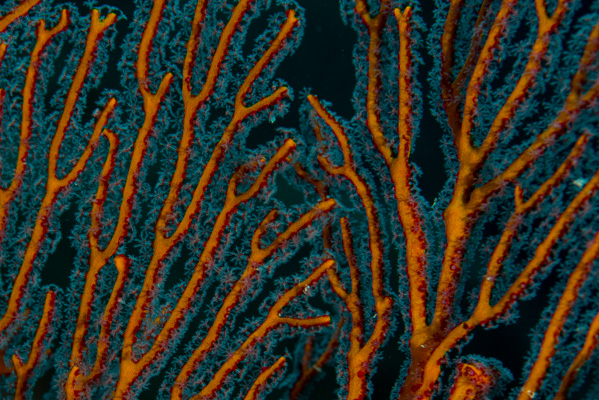
Another fan coral –– you can see the extended polyps here.

Some beautiful staghorn coral.

And another type of branching hard coral.

Here's a whole wall of mushroom coral.

And another type of meandering coral.
We're just starting to learn how to identify corals. It feels like a race, as they are disappearing almost as fast as we can learn what they are…

Here's a Moon Jellyfish.
The Yellow Submarine
And then there are the strange species of humans that we see out here.

Here's an example. The cream-colored yacht on the left is this guy's living space (you can just see the tail of his helicopter sticking off the port side upper deck). And the ship on the right is a tender, which carries all the toys.

The toys include this miniature yellow submarine.
This is probably just sour grapes, but we don't really see the point of all this. We think that scuba diving gets you a way more intimate experience with the ocean..
Maybe we would feel differently if we had a few billion dollars to spare!
Swimming with Manta Rays

We decided to make a stop at Nanuya Balavu Island. There is a channel here where manta rays come to feed almost every day.

These are really big creatures. But all they eat is plankton.

This was a bit of a tourist scene, but we put up with it to get close to these magnificent rays.

And they seem pretty patient and unperturbed about all the human attention.
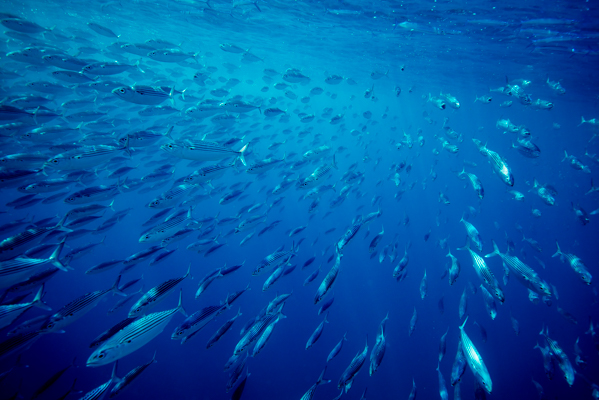
We also discovered a big school of Long Jaw Mackerel feeding in the pass.

These guys are also plankton feeders. Here the school approaches our dinghy, as we drift through the pass with the current.

And here's what they look like head on when they are feeding. Ken really loves this picture. He plans to title it something like "American Politics."
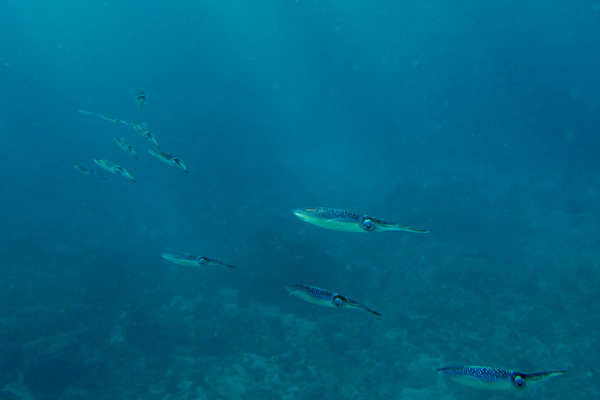
And finally, we encountered this school of small squid while we were snorkeling in a shallow bay.
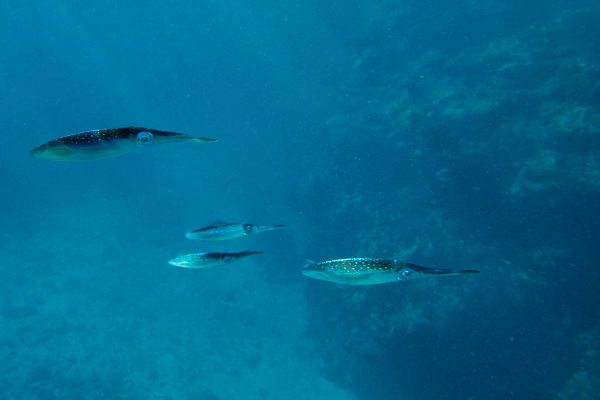
They always fly in formation –– all facing in the same direction, but sometimes just hovering in place.

And were not quite sure what this move was about. Looks like sex…
August 24, 2016 - September 2, 2016
And then finally, we returned to the major port city of Denerau, to stock up on provisions before heading on to Vanuatu.

There is one major problem with the cruising lifestyle. If you sit around on the boat too much, it's easy to turn into a vegetable -- or a potted plant. Ken was just hanging out on this bench with a couple of friends, when all of a sudden… poof!

Needless to say, Ken ran right back to the boat and got out our folding exercise machine!
September 2, 2016 - September 4, 2016
Passage to Vanuatu
Despite the fact that we have been sailing in this part of the world for 11 years now, the furthest west that we had ever gotten was Fiji.
This year for the first time, we finally pushed on to the island nation of Vanuatu.

Vanuatu lies about 600 miles downwind from Fiji. We had a fast passage and caught a nice mahi.
Fast, but eventful. For the first time in all the years we've been cruising we lost the use of both of our self steering systems at the same time –– meaning that we actually had to hand steer the boat! Most cruisers never hand steer, except in emergencies.
We're ok with hand steering for day sailing or racing. But on a long passages with only two people on board, having somebody on the wheel all the time is dreadful!
The first thing that happened was that the hydraulic ram for our autopilot tore itself loose from its mount.

Here's a picture of the ram. It's not supposed to be held up by string!

Here Ken drills through the mounting bracket so that he can through-bolt it back together.
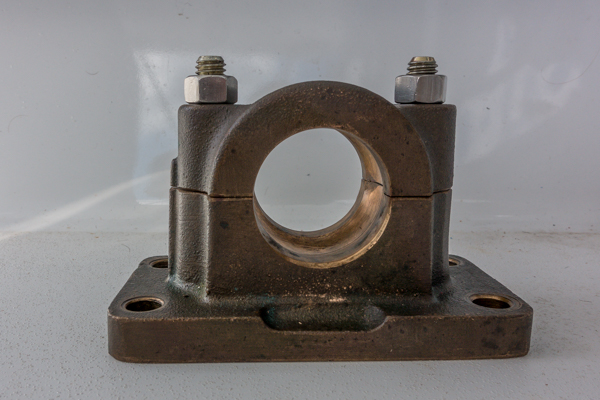
This is the mounting bracket after Ken has repaired it. The original bolts had screwed into the bronze housing. The bracket came apart because the bolts stripped out of their threads.

And here's the reason why. If you look closely at these two pictures, you will see that there is a small indentation in the base on one side, but not on the other.
That little indentation allows the hydraulic ram to fully articulate without bottoming out against the base. We had had a young hydraulic engineer in New Zealand take our system off for service, and we had allowed him to put it back on himself. He put the base on backwards, so that the indentation faced away from the hydraulic ram!
We went most of the season without a problem, but somewhere between Fiji and Vanuatu the arm tried to reach its fully articulated position. And it bottomed out on the base and just ripped the mounting bracket completely apart –– big forces involved here.
And we had only been doing preventive maintenance on the hydraulics. This goes to show that no good deed goes unpunished.
So with the autopilot not working, Ken went to hook up our Monitor wind vane And found that we had suffered damage when another boat swung too close to us at anchor in Fiji.
Ken was able to jury rig the Monitor and get it running again after about an hour. So we really only had to hand steer for an hour.
But that was enough. We decided to get a whole back up hydraulic ram and motor/pump for our autopilot when we got back to NZ.
And we also replaced all of the damaged Monitor parts when we got back to New Zealand.
September 4, 2016 - September 7, 2016
Vanuatu
We had special permission to make our first stop at Tanna Island, rather than the capital city of Port Vila.

As soon as we dropped our hook in Port Resolution on Tanna Island, one of the villagers paddled up to see if we were interested in trading AA batteries to get fish or fruit. He also asked if we could charge his cell phone...
People are still paddling dugout canoes in the outlying villages in Vanuatu, although obviously the modern world is creeping in.
Visiting the Volcano God
We had stopped at Tanna because we wanted to visit the volcano.
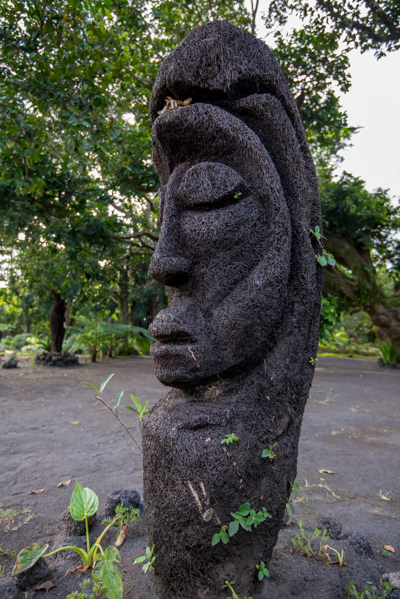
Vanuatu is a bit closer to its traditional culture than Fiji, because the missionaries didn't make quite as strong an impression here.
The NiVans, as they call themselves, are a bit coy when you ask them when they stopped eating people –– but it's pretty clear it's probably post-World War II, at least in the really remote parts of the islands.

However, they only dress like this when they are putting on a show. This was a traditional dance of respect for the volcano God.

Tell you what, that volcano God really does demand some respect.
The volcano is mighty impressive as it rumbles and spews out giant billowing clouds of blue, gray, white,
and black colored smoke. And you can see chunks of rock and lava shooting up in the air. After dark the hot
rocks shooting up looked like fireworks going off.

Unfortunately, the day that we went there, the volcano was throwing molten rocks at the lookout where you can usually go to look down into the cauldron.
And the guides were nervous about getting people killed, so they wouldn't let us go up there. Ken was bitterly disappointed, and would gladly have risked his life for a look at the lava. (Beth thought he was nuts.)
Still, the whole thing was quite a scene.
Ken swore that the next time he came here, he would bring a drone.
September 8, 2016 - October 21, 2016
From Tanna we moved on to Port Vila.


Vila has a fine harbor, but it's cluttered with numerous wrecks -- mostly from hurricane Pam, which had hit the place in 2015.
The wreckage still strewn all along the shore made us appreciate Sauvsavu, where the cruisers got almost everything cleaned up within one season.
In addition to the boats on the shoreline, there were a lot of boats sunk in the harbor.

We noticed drops of diesel oil coming to the surface near our first mooring –– obviously from a sunken boat. We had to move to a different mooring so that we could make water.
We were told that one of the sailboats moored here during Pam had vanished completely, along with her two-person crew. So there is probably a wreck with bodies in it somewhere down there.
We later dove to find the wreck that was leaking oil, but the water is murky and deep and we had not taken a GPS position on the oil, so we weren't able to find it.

There were some salvage operations underway –– this catamaran got towed off the shore while we were there. It made us a bit nervous as it went close by EW, looking like it might capsize right on top of us.
Port Vila is the bustling capital of Vanuatu. It's got good markets, good restaurants, and good transportation -- little privately owned minivans that will take you anywhere in town for $1.50 (in the company of whomever else they pick up in the meantime).

Students marching in a parade to celebrate athletics.

We also visited the Vanuatu Museum in Port Vila. It's not a huge place, but way more interesting than a typical museum. Because it has real people -- like Edgar here -- to explain the exhibits and demonstrate the local art.

This young man showed us how to do sand drawings.

After setting up the grid, an artist always does sand drawings in one continuous motion –– without lifting his finger. The drawings are beautiful and intricate. And when the artist is done with one, he just shakes this frame and it disappears –– gone forever, and ready for the next drawing. Kind of like an Etch-a-Sketch, except way more beautiful.
We thought that this process was worth a video. Click on the link to see Edgar demonstrating sand drawing ... Edgar Sand Drawing Demonstration

Some of the museum visitors try their hand at a local musical instrument. It's a bit like a xylophone, but made out of bamboo, and operated by vibrating the different sections with your hands.

A Tam-Tam, a hollowed out tree trunk with a carved head on top, which the NiVans used as a drum. Edgar explained to us how villagers would use these drums to send messages by pounding out different codes. A typical message might say that a man –– not a chief –– had died in the third village up the coast. Or else it might say that a chief was ill, but not dead, in the fifth village down the coast.
Of course these days the villagers all just use their cell phones!
But the best thing about Vila turned out to be the diving.
Diving Our Brains out in Vanuatu

We found that a 10 minute dinghy ride out of the harbor and up the coast got us to some really nice unspoiled dive sites. Just amazing when you consider that this is the capital city.
So we could have it all – a protected anchorage, good shopping, nice restaurants, and good diving all in the same place! We had never found a place like this since we left Bonaire, in the Caribbean.
Actually, we had a hard time anchoring our dinghy without dropping our anchor on good healthy coral. That's a nice problem to have –– these days most dive sites have big patches of rubble where the coral has been destroyed.

Luckily one of the local dive companies –– Big Blue – let us tie up to their mooring buoys, so that we didn't have to try to hit one of the small sandy patches amidst the coral. This is Fred, of Big Blue.
In return, we gave Big Blue a bunch of our pictures to use in their advertising.
And then we dove our brains out for a few weeks. After all our years in Fiji, we had almost stopped seeing new species. But the species change when you go to another island chain 600 miles away. In just two weeks in Port Vila we saw at least 50 species that we had never seen before. We were happy.

Here is a nasty looking, aptly named lizard fish.
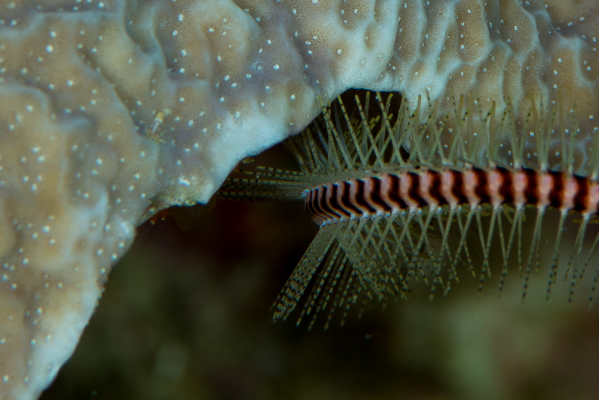
One arm of a Brittle Starfish, feeling its way out around a piece of coral.

A hawksbill turtle gives us a wary look.

This piece of modern art is actually a detail from the mouth opening of a giant clam.

This well-named Tubelip Wrasse uses his specially designed mouth to suck the juices out of coral polyps.

Fred told us where to look for this Leaf Scorpion Fish. This ambush predator waits patiently for one of those fish that you see in the background to make the mistake of getting close enough.

He looks for all the world like a dead leaf, and he knows it. He let us get within inches without spooking because he was just sure that we couldn't see him.

But this guy has added protection -- those spines on his back are poisonous and will leave you with a very nasty wound if you make the mistake of stepping on him, or putting your hand on him.
It pays to keep your eyes wide open underwater.

Soft coral.

These tiny Red Eye Hovering Gobies try to hide out on a bit of staghorn coral.
Unfortunately the white color of that bit of coral results from coral bleaching –– caused when the colored algae which live in symbiosis with the coral polyps get stressed by warm water temperatures, and desert the coral. This piece of the coral will now die, since it lacks the photosynthesis products provided by the algae.
We see an awful lot of this bleaching now.
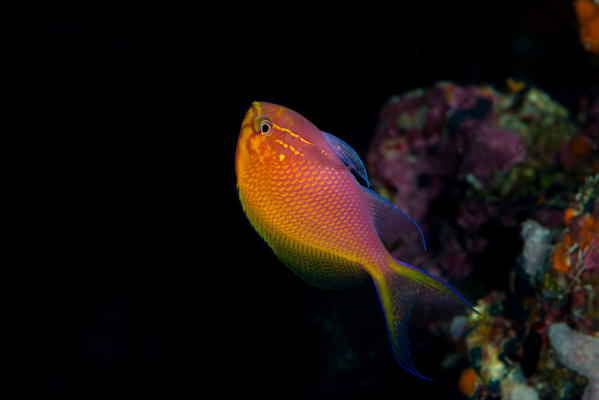
A gorgeous Hawk Anthias. These small fish hang out on the underside of coral ledges and shallow caves –– usually upside down. They are so adapted to life upside down that you have to look closely to tell which side is really the top. It's the left-hand side in this picture.

A Diana's Hog Fish.

A six-inch Pale Tailed Chromis, with a large parasitic isopod on its tail.
When they are small, these parasites lie in wait for a fish to brush up against a plant, or a piece of coral where the parasite is hiding. And once they get hold, they stay until they have grown large enough to fall off and breed.

Beth hates these pictures, but Ken thinks that we should show nature as it really is, and not sugarcoat things…

Of course, you don't necessarily have to dive on the reef to see wildlife. Here's a tiny shrimp that came up on Ken's wetsuit when he was cleaning the bottom of the boat.

And here's another little guy trying to look inconspicuous on our bottom paint.
October 21, 2016 - November 3, 2016
Back to WW II
And then finally we decided to tear ourselves away from the great scene in Port Vila and move up the island chain to Espiritu Santo.

Vanuatu served as a staging area for the American campaign in Guadalcanal during World War II. We saw lots of World War II wreckage lying about.
An Underwater World War II Junkyard

And "Million-Dollar Point" is probably the most famous spot.
When the Americans pulled up stakes to leave after the war ended, they decided it wasn't worth it to cart all of their military equipment back to the US –– they needed the space on the returning ships for their soldiers.
So the Americans left behind vast amounts of equipment –– bulldozers, front end loaders, trucks, jeeps, cranes, flatbed trucks and so on. And they offered to sell this stuff to the French colonial authorities in Vanuatu for really cheap.
But the French knew that the Americans weren't going to take this stuff, no matter what. So they refused to pay…
And the Americans, who didn't have much use for the French colonialists, decided instead to dump all their surplus equipment in the ocean!

The Americans picked a place where the beach dropped off rapidly to about 30 m depth. And then they lined up all the equipment, started the engines, put bricks on the accelerator pedals, and let the stuff drive itself out into destruction. It must have taken days.
And here's the funny thing –– in the long run this stuff was probably worth more under the water. Because it's now become a famous dive spot, and a big tourist attraction!
But today the NiVans get the benefits, since the French are gone.

Here's one of those deadly poisonous sea snakes, where we like to see them –– underwater.
As opposed to on our boat, where they like to come to sleep.

We also visited Peterson Bay, just up the coast from Santo. We took our inflatable kayak up one of the rivers to find the blue hole at its origin. We also visited our friends Elizabeth and Matt on "Rubicon", who were living on their boat in Peterson Bay.

We made friends with one of the local families in Peterson Bay. This is Phillip and Rena and Varinka, Emelie and Sela.



Did we mention that there is a lot of World War II junk lying around? Here Phillip shows off the bomb that he has standing outside his front door.
Ken said nervously "you know -- those things could still be dangerous." But Philip showed us a hole that somebody had drilled in the side of the bomb to take the explosive out.
This made us feel better.
Particularly about the fact that we were not around when the hole was being drilled...
November 3, 2016 - November 14, 2016
Then it was back to Port Vila to look for a weather window to New Zealand.

Passing the "Hat Island" on the approach to Vila.

Here, Beth contemplates a school? herd? flock? of sea urchins clumped together near the dinghy dock in Vila. Urchins feed at night, and seek shelter by day.
It's pretty interesting actually -- when we dive, we see lots of urchins in solitary holes in the coral. But this species has evidently adapted to life where there is no coral for shelter. So instead of seeking solitary refuge, they clump together to present predators with an imposing array of spines.
And they end up with the kind of gridlike spacing. Because, of course, nobody wants to get too close to a sea urchin –- including another sea urchin.

And, naturally, we had a few things to fix. Our watermaker had started running poorly. Here's the reason –– the brushes in the pump had worn out in less than one season of operation! The brush on the right is a new one –– the brush and the left just came out of the pump.

Beth tries to fix Ken's computer, which started running really hot. This happens a lot with powerful laptops in the tropics.
We needed to find a window for sailing to New Zealand, but it was November, and we were careful not to sail before November 8, because we wanted to be sure to see the US elections!
Even though everybody knew who the winner would be…
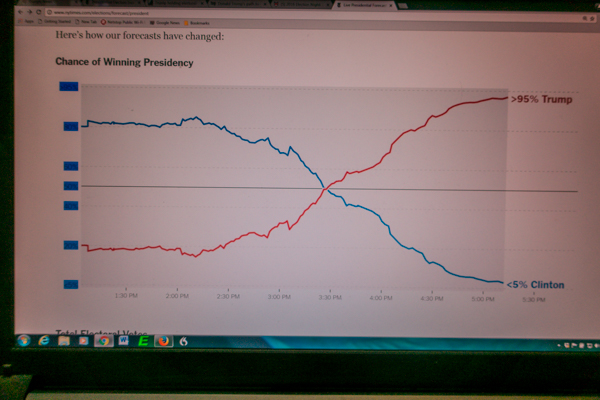
This graph says it all. This is the New York Times' estimated probability of victory for each candidate, by hour, throughout the course of November 8.

Beth could hardly contain her enthusiasm.
We decided it was definitely time to go to sea!
November 14, 2016 - November 23, 2016
Escape to the Blue
We had a long slow passage from Vanuatu to New Zealand –– because the South East trades are really not your friend on this particular passage.

But at least we had plenty of mahi-mahi to eat.
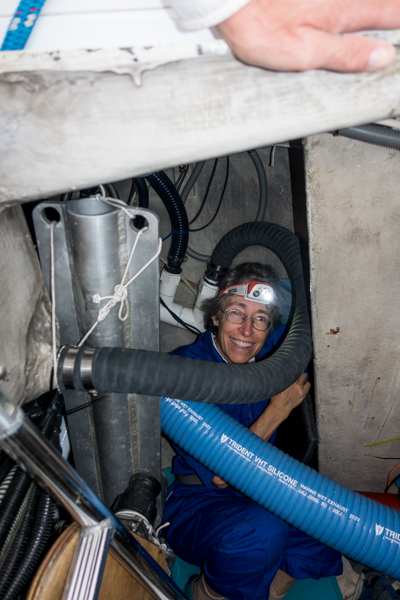
No passage would be complete without some kind of breakdown. Here Beth crawls into one of the lazarettes to bypass a link in the autopilot network. The autopilot had started making periodic hard-over turns to port. Fortunately this bypass solved the problem.
We had a 10 day passage to New Zealand –– very slow for us. But, hey, any passage where we don't get beat up is a good passage!
November 23, 2016 - February 23, 2017
Home Again in NZ
The first thing we did in New Zealand was to get out and do some hiking, and use our legs again.
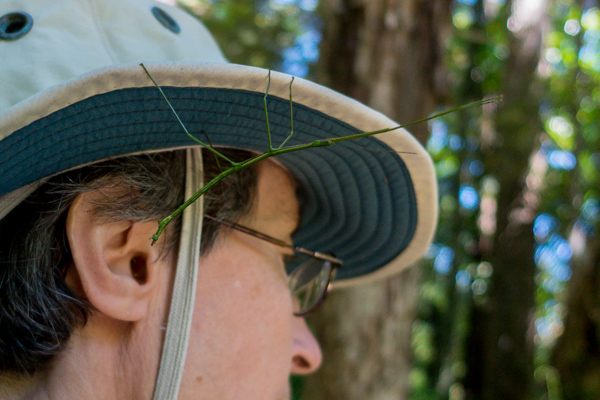
And Beth picked up a bit of the local fauna on her hat.

A "walking stick" –- a master of camouflage.
Fortunately none of the fauna or flora in New Zealand can really hurt you. Unlike Australia…

We spent a little bit of time getting ready for the local swap meet, a sale where boaters get rid of some of the "treasures of the bilge." We decided we might be able to pare down our supply of plastic plumbing parts a little bit.
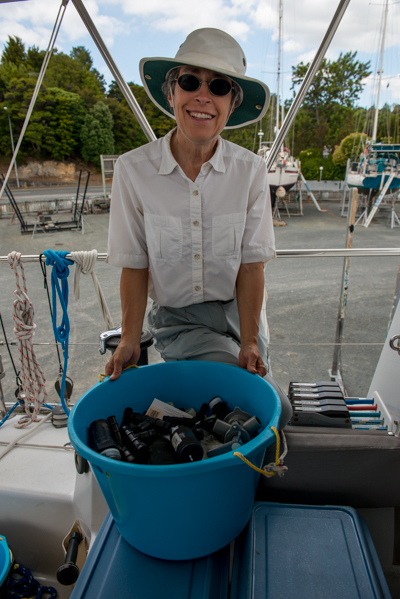
Here's Beth with the bucket of parts that we decided to sell. This was less than half of our collection, however.

We uncovered a few problems in New Zealand. For one thing, our bottom paint was blowing out around many of the metal fittings. This is caused by an electrical reaction between the copper based paint and some kind of current.
We took a lot of careful measurements, but we found no current leakage from any of our electrical systems. Instead this problem was caused by our having too much zinc below the waterline.
This is ironic, because boaters use zinc to avoid electrolysis issues –– the zinc acts as a weak link in the system, a "sacrificial anode" which will decay before any of your more valuable metals decay.
But too much zinc causes so much current that it can actually damage your copper-based bottom paint.
We had our doubts about this theory, but we reduced the amount of zinc we were carrying, and the problem disappeared.
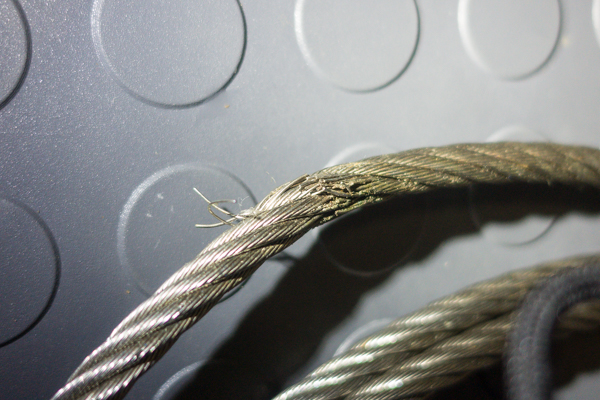
Another unexpected problem –– we discovered that both of our steering cables had broken partially. Even though they were only about a year and a half old!
This was operator error. It turns out that if you don't tension the steering cables pretty strongly, they will work hardened and break at the corners where they go around the quadrant. We had ours slightly too loose. Live and learn…
Then it was back to the US for another visit. Since this website is mostly about our sailing adventures, we won't say much about the trip back.
February 23, 2017 - March 27, 2017
Home To The US

We did take this interesting panorama in Minneapolis on a visit to Beth's cousins, Jim and Taffy.

And we watched our goddaughter Becky give her horse a massage.
Then back to New Zealand for the sprint to be ready for another sailing season.
March 29, 2017 - June 9, 2017

Storing spare parts takes a lot of time every season. Here Ken vacuum seals a new supply of 12 V fans to add to our spare parts inventory.
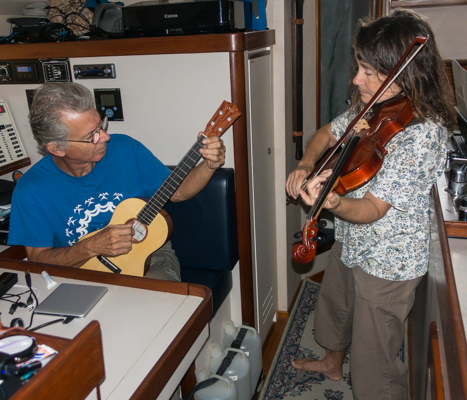
Art and Nancy of "Second Wind" have become are very good friends. They are concert musicians –– Art was a conductor in the orchestra where Nancy was a violinist. They came by to give us a farewell concert before they sailed off.

A really special moment...
June 9, 2017 - June 18, 2017
On The Road Again

And then back on the water for another passage to Fiji.


Despite his smile, Ken wasn't too happy about catching this skipjack. In fact he gaffed it before he realized what it was. Skipjacks are the tuna in the "dark meat" tuna cans. We think they are best used as cat food.

Here's a better catch -- a yellowfin tuna –– the filet mignon of the sea. Does Ken look happy here?
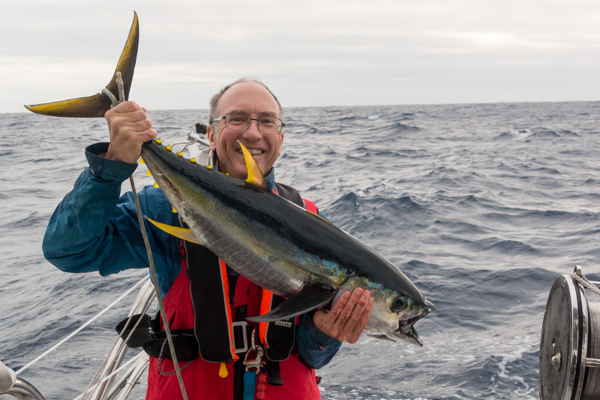
A better look at this magnificent fish. We don't see many of these anymore, as the tuna boats are just simply way too efficient at killing them.
June 18, 2017 - July 8, 2017
Back In Fiji
We really wanted to spend a lot of time in Vanuatu this season, but we went to Fiji first, for two reasons. First, we wanted to see our friends Hans and Dori again on Koro Island.
And second, we had heard about some crazy Fijians who were hand feeding bull sharks and tiger sharks in Beqa Lagoon, and we felt we needed to be part of that.
Well, not part of the food, hopefully…

As usual, we checked in at Savusavu. We really like this clean, low-key Fijian city, with its courteous customs and immigration officials, and its beautiful waterfront.

We saw lots of road construction around Savusavu.
We see more and more of this in the islands. We aren't sure, but we think that this is probably Chinese money. "Soft power."
We spent about 2 weeks longer in Savusavu than we expected, as Beth was recovering from a burn she got while making brownies. Who knew that chocolate could be dangerous...
July 8, 2017 - July 13, 2017
A Happier Visit To Koro
We headed back to Koro to see how Hans and Dori were making out after Winston.

There was still plenty of evidence that cyclone Winston had been there, but many of the homeowners had made a lot of progress in rebuilding. This house looked a lot better than last time we saw it.

Here's the same house, one year earlier.

A view of "Hans and Dori headquarters." Notice the new road construction in the foreground. Again, we're not really sure who is paying for this, but we suspect Chinese soft power.

Boy, Hans and Dori just looked so happy this time around.

They were making fantastic progress in the house. As you'll see in a moment, they had completed a good living area under the platform –– where it was pretty protected from storms. And they were well on the way to building their geodesic domes on top of the platform.

And now the shower dome actually had a composting toilet and a working shower (gravity fed from the water catchment).
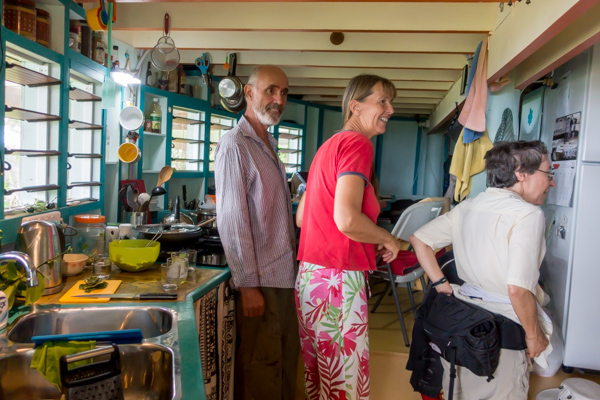
Hans and Dori had built a whole living quarters below the platform, complete with a kitchen and bedroom. They have a right to be pleased.
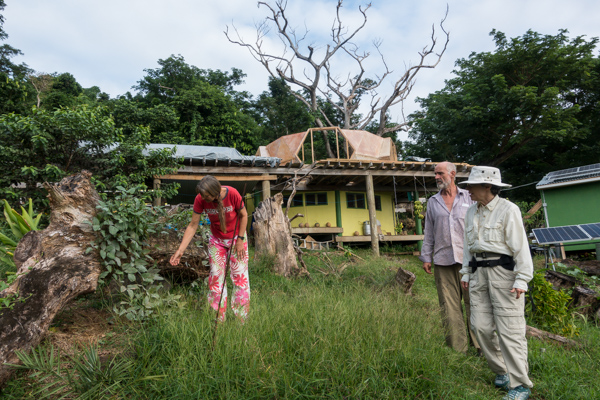
Here's what it looks like from the outside. And Dori shows off one of her pumpkin vines. Off to the right you can see some solar panels –– which basically provide all of their electricity. Hans and Dori have a generator but they say that they never run it.
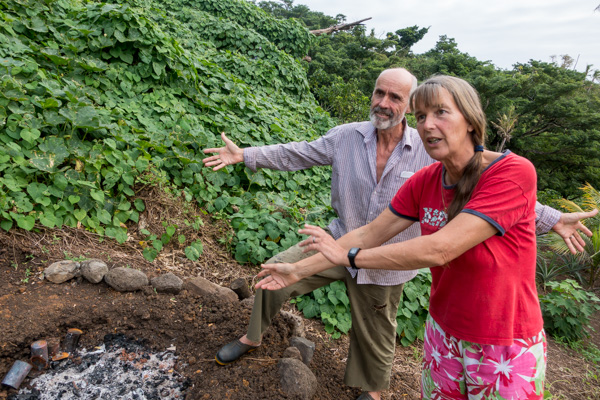
Their garbage disposal – – a burning pit.

A real sign of life returning to normal -- a tree full of papayas. These trees had been completely stripped of both fruit and leaves after Winston.
July 14, 2017 - July 23, 2017
Ono Island
From Koro Island we moved on to pay a brief visit to Ono Island, which is part of the Kadavu Island group. We hoped to dive there, but the wind didn't cooperate.

But we paid a visit to the village in order to do our sevusevu (a gift of kava to the chief). After we had finished the ceremony, the chief told these three delightful kids to show us around the village.
Of course they took us to the church, always the biggest and most impressive building in any village.


This young fellow was definitely on his way to becoming a preacher. He really wanted to be up behind that lectern.

They were just such nice kids. Here they are carrying our jackets and bag.
July 24, 2017 - August 5, 2017
Paparazzi
After just a day or two at Ono, we moved on to Beqa, where we would do the shark dive.

When we pulled into the small anchorage at Yanuca Island, we discovered this large team of people who were in the middle of filming a movie. The movie, which will be called "Adrift" is based on the book "Red Sky in Mourning" by Tami Ascroft. It tells the true story of a young woman who survives a storm where her sailboat is rolled over and her boyfriend is swept away.
The film crew asked us to move our anchor position -- twice -- in order to get our boat out of the way of the scenes they were trying to film. But they were nice about it, and we didn't really mind.

We had been planning to go diving, but watching the movie making was way more interesting. Ken felt like a paparazzi when he got the shot of the lead actress climbing into the water to cool off in her skimpy bikini.
Diving in Beqa
The next day, we got right down to diving. We hadn't been in the water since the previous season, and we wanted to be thoroughly practiced and comfortable for the shark adventure. The water clarity was amazing and we saw some beautiful creatures and coral.
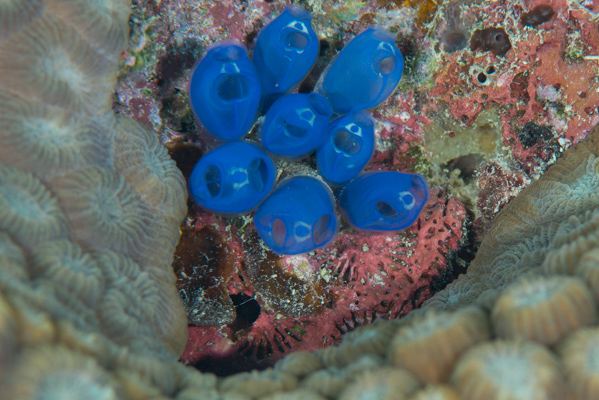
These little things that look like blue plastic beads are called "tunicates." They are a relative of sponges, but are slightly more sophisticated, with more differentiated organs. They take water in one of their two holes, pass it through some filters and then pump it back out the other hole.

Here is a beautiful coral fan with two small brittle starfish hanging on.
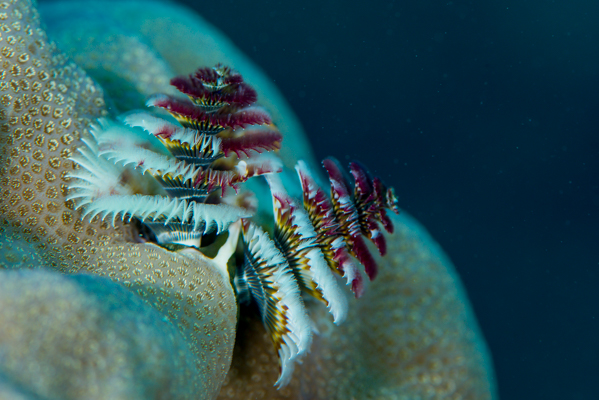
Christmas tree worms.

A detail from the previous picture, where you can really see the intricate structure of these tiny animals.

Beautiful soft coral.

A white -tipped reef shark comes by to check us out.

Here's a close-up. We are no longer the least bit intimidated by these fellows. In fact, we are planning to dive with the big guys who eat these white tips for lunch.

Here's another tunicate. There are thousands of species of these things.

A sling-jawed wrasse, showing how he gets his name. When he retracts his mouth parts, he looks like an ordinary fish.

A school of small squid –– maybe 6 inches long -- started hanging out around Eagle's Wings, so Ken went in to get some pictures.


While at Yanuca, we also discovered that we could fly our dinghy as a kite when the wind gets up a little bit!

Ken knew that he would have to use a wide angle lens on the shark dive, so he put one on his camera rig for practice. He kind of like the results –– maybe this wide-angle stuff is okay after all.



We couldn't really decide which picture we like the best, so we just put them all in the website. Why not?

We also paid a visit to the village on Yanuca Island.

We had to hike a little bit through the woods, since the village is on the windward side of the island, where we can't anchor.

But the hike paid off, as we got to see their brand-new water desalinization plant.
Yanuca is a low island, so it doesn't get much rain. Sometimes the villagers can run short on drinking water.

This set up looks complicated, but it's really dead simple.
The villagers carry ocean water up from the beach (about 50 feet away) and put it into one of the larger green barrels. From there it gets pumped by a small solar powered electric pump up on to the large panels.
The large panels look like solar panels, but they aren't. Instead they are just aluminum frames, with a black felt base and a clear plastic cover. The salt water gets pumped to the top of the panel and then drains down inside along the felt. The heat of the sun on the black felt evaporates most of the water, which then condenses on the clear plastic cover.
And the condensed water runs down the plastic, gets collected in the trough at the bottom and feeds by gravity into the smaller green barrel.

This is Seva, who showed us the desalinization plant. He said that a Fijian Indian -- a graduate of the University of the South Pacific in Suva -- had recently helped them install the structure.
Seva pointed out that part of the beauty of this system was that it only ran when there was enough sunshine to power the pump. And if there was enough sun to power the pump, then there was enough sun to evaporate the seawater and make fresh water.
So at night or in cloudy conditions the system just automatically shuts itself down. Pretty clever.
We just hope that a hurricane doesn't get these things, though.
Conspiracy Theories in Paradise

We also met Levi, a schoolteacher in the village on Yanuca. He seemed like a very nice young man, and as a recent graduate from Suva, is one of the better educated people on the island.
But as soon as he learned we were Americans, he asked us if we knew about Alex Jones. Then he proceeded to tell us that he had learned from Alex Jones that the World Trade Center bombings, as well as World War I and World War II, have been the work of the Jesuits.
And he told us that the Jesuits were rapidly taking over in Fiji... This was news to us.
So along with cell phones, we can see that the benefits of the Internet are starting to arrive in Fiji.
Seriously though, Fiji has always been a place of remarkable religious toleration, with Wesleyans, Methodists, Catholics, Seventh-day Adventist, Mormons, Hindus and Muslims, among others, all living side-by-side without much conflict.
(There have been some conflicts between the Fijians and the Indian population, but that conflict has had nothing to do with religion and everything to do with economics and culture.)
We were shocked that a crackpot conspiracy theorist like Alex Jones had gotten his tentacles into a place like Fiji –– where he had probably never even set foot. Will this make Fiji a happier place?
Diving with Tigers
And now it was time for the main event –– the reason we had come to Fiji in the first place this year. A chance to put our lives on the line by diving with the most dangerous sharks in the ocean.

The dive company goes out a couple hours ahead of time and puts a whole bunch of fish chum in a cage. That gives the sharks time to congregate. Along with every other fish in the vicinity.
Then we all go down to the bottom and try to look small behind a little bit of coral rubble, while the Fijian dive masters feed the sharks.
This sort of reverses the normal idea of cage diving –– where you put the divers inside the cage and the food on the outside!
A couple of the Fijian guys stand on the bottom behind the paying divers to fend the sharks off with shepherd's crooks if they get too inquisitive.
Oh, and they won't let you wear yellow, or other light-colored dive fins. It turns out that the whole "Yum Yum yellow" thing with sharks is actually true.

Our friend Damien on the boat "Colibri" took this spectacular picture of a Bull Shark. Note the fishing hook stuck on the corner of the shark's mouth.
Just in case Bull Sharks weren't irritable enough to begin with...

The Tiger Sharks liked to swim along the bottom, get their food from the Fijian guys and then swim right over the top of the waiting divers. Sometimes they got so close that you could reach out and touch them.

Beth, capturing the action.

Yikes! Ken's favorite picture. You can see from her stripes that this is a Tiger Shark.

And if you're knowledgeable enough about shark teeth, you can identify this shark as a Tiger.
Honestly, we would prefer not to be close enough to identify Tiger Sharks by their teeth…
But, surprisingly, this whole thing felt very under control. The sharks had easy food, and didn't pay any attention to all the nice fat, juicy fish and/or nice fat, juicy divers hanging around.
And the Fijian dive masters operating out of the Beqa Lagoon Resort were just incredibly professional –– we can't say enough good things about this operation. It was a great experience.
In our 13 year voyage, this was definitely one of the high points.
Celia, on "Colibri" took the following videos, and graciously allowed us to post them on our website.The videos capture the feeling in a way that still pictures can't.
Beqa Shark Dive Video 1
Beqa Shark Dive Video 2
Beqa Shark Dive Video 3
Beqa Shark Dive Video 4
Anyway, that's going to be the end of this long update. We are presently in Vanuatu, looking for a weather window to go to New Caledonia. But that's all just for the next edition.
Talk to you again soon, hopefully before another two years go by…
|

